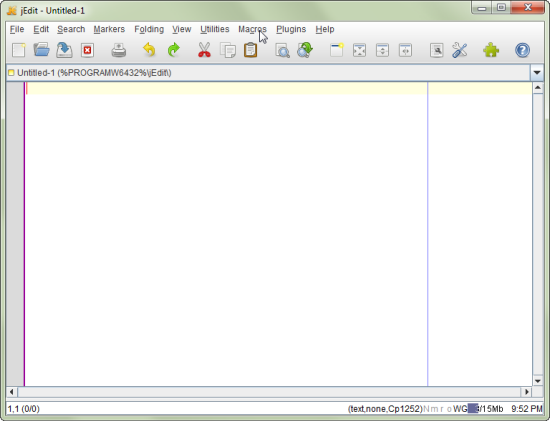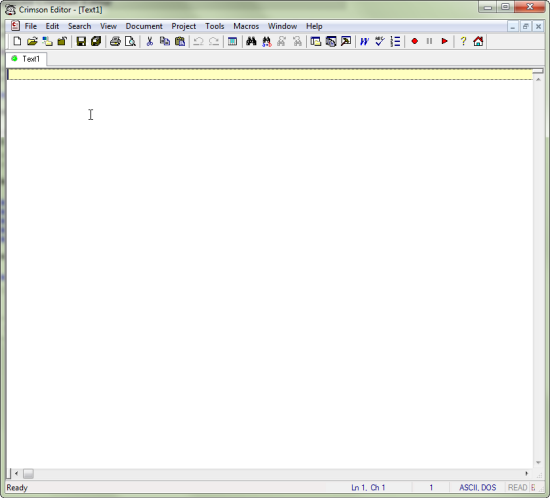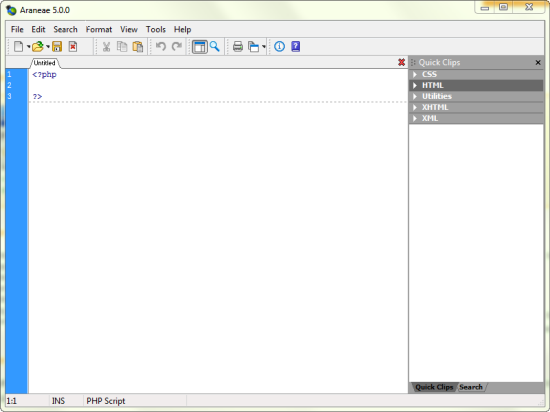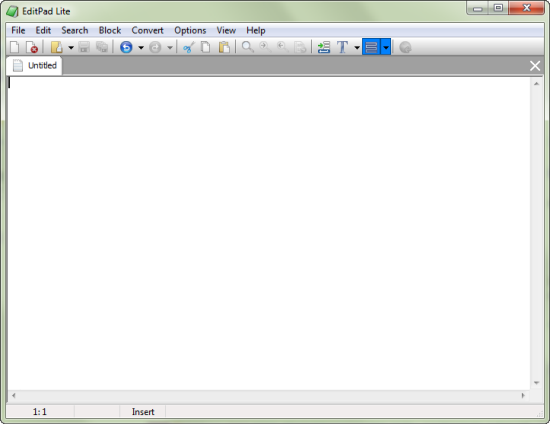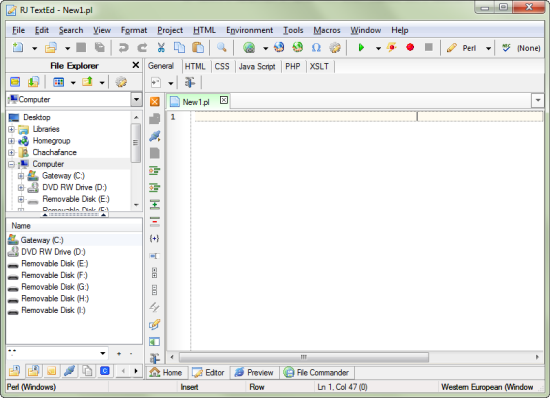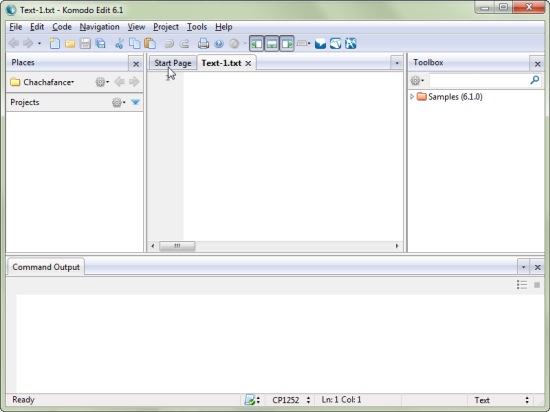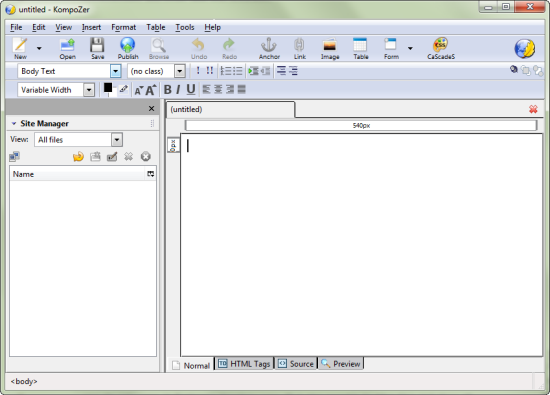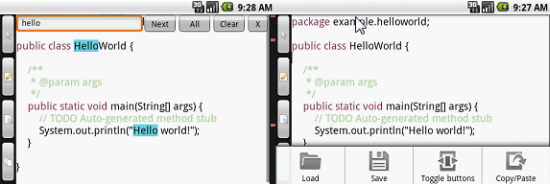If you're new to programming (or new to programming in a particular language) you might be looking for an IDE — that's an
integrated
development
environment,
the handy, dandy piece of software that acts as text editor, debugger
and compiler all in one sometimes-bloated but generally useful package.
Unless you're committed to working in a text editor and a command prompt window (and there are
compelling reasons
for doing exactly that) you might be looking for some advice on how to
choose a good IDE, the pros and cons of various varieties, the relative
costs (financial or system resources) of running a particular IDE, what
other languages the IDE might handle well, the operating system(s) it runs on and ever so much more.
I was recently in need of such advice, myself. As some of the readers
of this blog know, I recently went back to school to study computer
science. Being an utter novice, I made the mistake of asking developers
in my sphere what IDE I should use.
The topic is apparently a minefield of catastrophic proportions.
Developers are passionate, experienced and opinionated when it comes to
optimizing their workflows, and recommendations (and
anti-recommendations, e.g., "NetBeans is superlatively bad and will turn
your hardware into Cream O' Wheat!") fly like shells over a
battlefield.
Here's a less opinionated, concise but thorough look at IDEs for the
new programmer. If you need more detailed information or want to find an
IDE for a less common programming language, check out the
Wikipedia article comparing just about every IDE known to humankind.
And if we left out an IDE you particularly love, let us know about it
in the comments — but try to keep the NetBeans/Eclipse, Vim/Emacs
flamewars to a minimum.
IDEs Built from Text Editors
It's a slightly more complicated setup, but some pro developers swear
by these workflows, which take a lightweight, run-of-the-mill text
editor and turn it into a full-fledged, be-all-end-all IDE.
Ars Technica
has an excellent step-by-step article on how to turn Vim into a great
IDE using Exuberant Ctags, completion modules, script collections and
more.
Emacs users can also use commands to make this editor more developer-friendly. And of course, this topic gets a
thorough discussion at StackOverflow.
When in doubt, search Google for tips on turning your favorite text
editor into a great IDE for your language of choice. Chances are
someone, somewhere has already attempted it and is willing to hand out
advice.
Multi-Language IDEs
As a beginning programmer, you might not need tools for coding in Ruby
and Python
and C++
and PHP, but if you're aiming for a multi-language career later on, you might consider learning the ropes of a multi-language IDE.
One kind
gent
(or lady) on Hacker News wrote, "Although many IDEs can handle more
than one language, few do it well. Plus, it's likely overkill if you are
just getting started." This individual suggested instead using a simple
text editor such as gEdit (Linux) or TextMate (Mac) for multi-language
practice.
Languages: C, C++, Python, Perl, PHP, Java, Ruby and more
Price: FREE
Eclipse is the free and open-source editor upon which many
development frameworks are based. It's one of the granddaddies in its
field and comes highly recommended by many a professional developer.
Eclipse began as a Java development environment and has greatly expanded
through a system of lightweight plugins.
Languages: Java, JavaScript, PHP, Python, Ruby, C, C++ and more
Price: FREE
NetBeans is neck-and-neck with Eclipse as the most-recommended IDE in
this category. It's free and open-source, supports tons of languages
with more plugins coming all the time, and is incredibly simple to
install and use, even for a beginner.
Languages: Perl, Python, Tcl, PHP, Ruby, Javascript and more
Price: $295
This enterprise-level tool might be best for the pro developer
because of its higher price point. For beginners, you might also want to
check out the Komodo-based, FOSS editor
Open Komodo or Komodo's FOSS version,
Komodo Edit.
Languages: HTML, CSS, JavaScript, AJAX and others via plugins
Price: FREE
Aptana is a popular choice for web app development. Aptana Studio 2
can be used as a stand-alone IDE or can be plugged into Eclipse. Aptana
comes with Firebug support built-in, and its developer community seems
to release plugins for other languages as needed.
Languages: Python and Ruby
Price: $59.99 (personal developer license)
This IDE is designed for Python and Ruby devs creating apps for
Windows and Linux. It includes a text editor as well as a GUI designer
that uses pyQT and QT Designer. The makers of BlackAdder allow you to
test drive the IDE in a limited
demo version.
Languages: C, Java, PHP, HTML, Python, Perl, Pascal and a boatload more
Price: FREE
Geany bills itself as a "small and fast" IDE, but it is by no means a
lightweight. Its list of supported languages is about a block long;
it's highly customizable; and it features a robust set of plugins which
is open for hacking.
Here's a chart showing the differences and similarities between a few
multi-language IDEs. An asterisk denotes the need to use a third-party
or other plugin to achieve the desired functionality. The .NET column
indicates support for .NET languages, particularly C#. "FOSS" is the
acronym for "free and open-source." Click the image to see a slightly
larger version.
IDEs for Mobile Development
These days, developing mobile applications is one of the most
compelling and exciting reasons for learning how to code. We're still
looking for that perfect, all-in-one,
cross-platform
mobile app IDE — in fact, we particularly welcome your comments and
suggestions on this score — but here are a few ideas to get you started.
Try some of
PhoneGap's
cross-platform tools. PhoneGap works with Xcode and Eclipse for iPhone
and Android, respectively. You could also try the web-based, hosted
RhoHub, which allows for git-powered source control and team collaboration.
Another good bet for mobile developers is
Appcelerator's Titanium Mobile,
which lets you write in any language/IDE you choose, then translates
your code to Objective-C or Java. You can also check out our list of
cross-platform mobile development tools. Finally, the mobile development products (and resultant applications) from Adobe are getting
more interesting all the time — we highly recommend keeping an eye on their developer tools.
Also, if you're already using a multi-language or other IDE, check
the web to see if a mobile-development plugin already exists; many IDEs
such as Eclipse have this functionality.
Web-Based IDEs
If you're working remotely or need a last-minute fix, these IDEs might be worth looking into.
Languages: ASP.NET, PHP, Ajax, C#, JavaScript, CSS, HTML and more
Price: FREE
This broswer-based IDE works in Chrome, Firefox, Safari and even good
old Internet Explorer. Like the more robust multi-language IDEs,
CodeRun supports Visual Studio projects and .NET languages. Best of all,
your code is sharable via hyperlinks; it's even got built-in social
sharing tools, should you want to tweet your code.
Languages: PHP, HTML, CSS and JavaScript
Price: FREE
ShiftEdit brings revision history and code snippets to the browser.
Any files you access will stored until next time you log in. This IDE's
text editor is based on Mozilla's Bespin (mentioned below).
If you need a collaborative, web-based code editor — great when
working on joint projects or as part of a team — you might also want to
check out
Squad. And for HTML5-based code editing, try Mozilla's
SkyWriter, formerly codenamed Bespin.
IDEs for Microsoft/.NET/C# and Apple/iPhone/Mac Devs
Some languages require a bit of special handling; not all
multi-language IDEs support all languages, and if you're working with
the Cocoa API, for example, or with a .NET framework language, you might
want to consider something more specifically suited to a Microsoft or
Apple development environment.
Another part of this category includes single-platform IDEs such as
Coda and Espresso. They only run on Mac Operating Systems, but they
allow for multi-language development within a very Apple-flavored GUI.
Languages: Visual C++, VB.NET, C#, F# and others
Price: $549
Visual Studio is Microsoft's IDE. If you're building Silverlight apps or planning on working in a .NET shop (such as
MySpace),
you may want to spend some time with Visual Studio. Visual Basic has
some support for non-Microsoft languages such as Python and Ruby, but
you'll have to install those services yourself. A free, limited-time
trial version is available.
Languages: Objective-C, Objective-C 2, Cocoa and Cocoa Touch APIs
Price: FREE
This IDE is just for creating iOS and Mac apps. If you're thinking
along Apple-y lines and want to get into iPhone or iPad development,
Xcode might be your first stop. This IDE includes an iPhone simulator
and GUI builder, too.
Languages: C/C++, Visual Basic, C# and other .NET languages
Price: FREE
Monodevelop is a good option if you're working in a .NET languages
and don't want (or need) to fork over the $550 for Visual Studio. This
free-as-in-beer IDE also allows you to port your apps to Linux while
maintaining a single codebase.
Languages: HTML, CSS, XML, JavaScript and PHP
Price: $79.95
Espresso, a tool for Mac web devs, comes from the makers of CSSEdit.
Its supported languages and other features are extensible through
plugins known as "Sugars."
Languages: PHP, JavaScript, CSS, HTML, AppleScript and Cocoa API
Price: $99
Coda bills itself as "one-window development" for the Mac user, and
its a favorite of many developers on this platform. It's a full-featured
IDE, but one of its most interesting features is live collaboration
with other users.
It's not delirium tremens; it's just an elePHPant.
IDEs for Specific Languages
Here are a few suggestions for IDEs that cater to developers working
in a single language. Some of these options are more costly than others,
but most of the non-free IDEs here will also have a free trial version
available for you to test-drive the software, learn to use it and decide
whether or not you need and want its features and interface.
We only have space to highlight a few of the more popular programming
languages here. If we left your preferred language out of this list,
search
StackOverflow for IDE recommendations, or ping the friendly devs over at
Hacker News for their advice.
C/C++
C/C++ languages are some of the most widely used in the world of
computer programming. Almost every multi-language IDE will support
C/C++, but here are some dedicated IDEs just for C programmers.
Bloodshed Dev-C++Price: FREE
Code::BlocksPrice: FREE
CodeLitePrice: FREE
C-FreePrice: $79.95 (single-user license)
Java
Yeah, yeah, I've heard about how much Java sucks more times than I
can recall. But it's used in the Android stack as well as in a lot of
intro-level programming courses, so here's a lineup of good Java IDEs.
JikesPrice: FREE
JcreatorPrice: $89 (single-user license)
IntelliJ IDEAPrice: FREE
Python
Never mind the fu and bar, here's some spam and eggs. If you got that
reference, you might want to check out these links. Here are a few IDEs
dedicated to Python, a powerful, readable and fascinating language. For
more suggestions and comparison information, check out this exhaustive
StackOverflow list of Python IDEs.
IdlePrice: FREE
PyCharmPrice: $49 (personal license)
PidaPrice: FREE
WingPrice: $35 (personal license, single OS)
PyscripterPrice: FREE
PHP
PHP powers some of the most ubiquitous web apps around today, from
WordPress to
Facebook.
Many of the free multi-language IDEs also support PHP development. Here
are some full-featured, pro IDEs we've seen recommended.
PHPStormPrice: $99 (personal license)
PhpEDPrice: $119
Zend StudioPrice: $399
PHP DesignerPrice: $45 (personal license)
Ruby/Rails
For a relatively young language, Ruby gets a lot of mileage, from consumer-facing apps like
Twitter to dev-centric sites such as
GitHub. In addition to these IDEs, also check out
Ruby In Steel, a Ruby tool for Visual Studio, and
Heroku, the so-hot-right-now PaaS for Ruby apps.
RubyMinePrice: $99 (commercial license)
RedcarPrice: FREE (and still under development)
RadRailsPrice: FREE
Use What You Love, Love What You Use
Finally, after scores of links and a huge data-dump of information,
we can only tell you this: Developers are passionate and opinionated
about their IDEs because each individual has researched, chosen, used
and come to appreciate a specific IDE (or set of IDEs) for personal as
well as practical reasons.
We recommend you try out a few of the free (and free trial) IDEs
before making a hard and fast choice as to what you'll use, but you
should ultimately use the IDE that suits you best and makes you
happiest. Anyone else's recommendations are just highly subjective
suggestions.
We wish you well, and happy coding!
Disclosure: The author of this post uses gEdit, Notepad, NetBeans, JCreator, and a magnetic needle and a steady hand.


